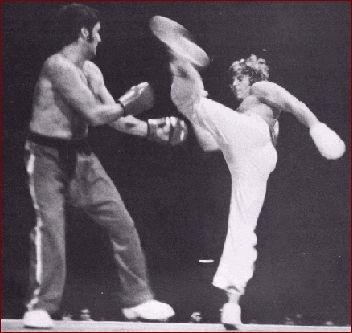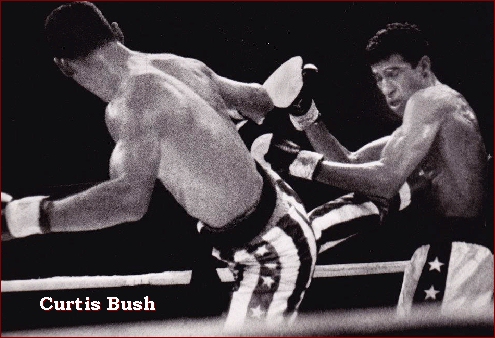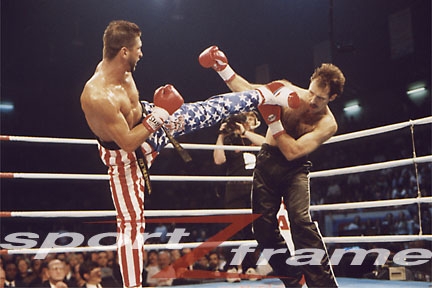IKF PRESS RELEASE
"High
Kick Kickboxing"
HOME -
NEWS -
EVENTS -
RANKINGS
- SANCTIONING
- JOINING -
RULES & REGULATIONS
-
MERCHANDISE
-
CONTACT
THURSDAY, November 16th, 2017, AT 4:30 PM/ PST
Some Fighters, Trainers & Promoters Asked For This, So IKF Comes Through...
Great News...
A New
Reason to Kick High!
IKF
Modifies Rule Style Formerly Known as
"Full
Contact Rules = High Kick Kickboxing"
The Boot is Now Optional - Shin / Instep Guards
Only…Now Acceptable!
Good news for those that prefer the Old School Style Kickboxing where all kicks are above the waist! Regardless of what name you call it…the aforementioned rule style is what was in large responsible for where the sport of Kickboxing is today as well as in part responsible for the growth of Muay Thai in this country! Great high kicks like front kicks, round kicks, hook kicks , spin kicks etc and a combination of all of them where highlights on regular TV Programs like ESPN and had a huge fan base! Hooray! It's back!
Great fighters like
- Don "The Dragon" Wilson
- Rick "The Jet" Roufus
- "The Iceman" - Jean Yves Theriault
- Troy "The Destroyer" Dorsey
- Johnny "Superfoot" Davis
- Curtis "The Explosive Thin Man" Bush
- Joe Lewis
- Stephen "Wonderboy" Thompson
- Jerry "GoldenBoy" Trimble
- Benny "The Jet"" Urquidez
- Dennis "The Terminator" Alexio
- Leroy Taylor
- Anthony Elmore
- "Bad" Brad Hefton and the list goes on and on
If not for the legendary Joe Lewis, we might not even be having this conversation...
It was in the late 1960s when American national karate champion Joe Lewis had become so fed up with the way tournament karate was scored that he contemplated a professional boxing career. He felt strongly that karate matches on the tournament circuit routinely went to the wrong fighter. The scoring system was just goofy. It required judges to decide which light-contact blow might have hit with power and to count how many judges agreed that they had seen it hit … or, rather, had "theoretically" hit. Lewis responded by training for the ring with the likes of Bruce Lee, Joey Orbillo and Sugar Ray Robinson.
When Lewis' own black belt student, former Vietnam Green Beret Lee Faulkner, asked him to participate in Faulkner's light-contact invitational 1st Pro Team Karate Championships, Lewis agreed... provided Faulkner also promote a "Full-contact karate" bout inside a boxing ring for the finale.
On January 17th, 1970, Lewis knocked out Greg Baines for the US Heavyweight Full-Contact Title. The competitors wore boxing gloves and sneakers. Faulkner initially called his promotional organization the Professional Karate Association, as seen at the bottom of the event poster (Click Here For The First Ever Full Contact Karate Poster), but immediately changed the name to the United States Kickboxing Association. Although Lewis and Faulkner intended at that time to call the new hybrid sport full-contact karate (as opposed to light-contact), the event ring announcer referred to it as kickboxing and the name stuck.
From that event, it was a step up for martial art / karate fighters who wanted to add more serious contact to their game.
It was in 1973 when Heavyweight Champion Joe Lewis and the Senior Vice-President of Universal Studios Tom Tannenbaum conceived the idea of a fully sanctioned full contact karate tournament. Promoters Mike Anderson and Don and Judy Quine came together to form the Professional Karate Association (PKA).
Full Contact Karate got it's "Official" start and its official TV Debut on September 14th, 1974, with the live event drawing over 10,000 spectators to the Los Angeles Sports Arena in California for the first World Championships promoted by the PKA.
Some of the champions crowned at that very first event are now Martial Arts legends such as Joe Lewis, Jeff Smith and Bill 'Superfoot' Wallace. As noted above, the term "Full Contact Karate" was already being discussed to be changed to "HIGH KICK" rules. Many great fighters fought through the years under the PKA with the notable inclusion of Benny 'The Jet' Urquidez. These fighters have now achieved immortality in the world of Martial Arts.
The promotional event named the World Professional Karate Championships and was sanctioned by the Professional Karate Championships subsequently aired twice, as a 90-minute national broadcast, on ABC-TV's Wide World of Entertainment, first on December 27, 1974, at 11:30 PM. and, for the first time for a martial arts event, attracts media coverage from major network sports news, Sports Illustrated and the Los Angeles Times. Even though broadcast opposite Johnny Carson's Tonight Show and, the show garnered an astounding 52 share of the Nielsen ratings that night. From this event, the sport of professional kickboxing took off, spread throughout the world.
Back in it's heyday, it wasn't competing against other martial art styles (Muay Thai, MMA, Etc.) for TV time and because of this, it was a regular program on ABC Wide World of Sports, followed by ABC's new station, ESPN.
Those first championships were held on a matted area and attracted enormous worldwide media interest and television coverage.
In 1977 Joe Corley joined the PKA and together with Jerry Piddington organized the committees that would control the sport of full contact karate for the next 9 years. The PKA went on to have a long term relationship with ESPN that lasted until 1986, while also airing a series of fights on CBS under the watch of CBS Sports VP Barry Frank and on NBC via Sean McManus. The PKA was by far the most visible sanctioning body for what became better known as kickboxing in the United States, in 1982 sanctioning 43% of events worldwide and producing more than 1,000 hours of television content.
The PKA signed many fighters to exclusive contracts in order to build its brand in the sport, just as most other sports organizations sign athletes to exclusive contracts. Some fighters chose to go to other competing organizations, but the PKA was by far the most well known, as were its fighters. The PKA sanctioned fights exclusively with what has become known as "full contact rules" which permit kicks only above the waist as opposed to the "international rules" advocated by other organizations.
In 1989 Joe Corley gained the rights to PKA in an out of court settlement ending a 3 year dispute with his PKA partners. The PKA has since operated as a promotion company and not a Sanctioning Body."
Throughout the following years the PKA hosted fights with SHOWTIME through the 90s and held its first pay per view event with SHOWTIME featuring "The Iceman" - Jean Yves Theriault vs Rick "The Jet" Roufus, Dennis Alexio vs Dick Kimber and Paul Vizzio vs Juan Torres. However this was it's last large TV Promotion.
Prior to this event, Corley and his Showtime PKA Promotional company featured one of their events on January 22nd, 1994 at Tahoe-Stateline, Nevada named "Karatemania". on the event the IKF sanctioned two IKF Pro World Titles which included:
- Vacant IKF Pro World Full Contact Rules
Light Welterweight Title
Juan Torres (139 - South Lake Tahoe, CA - 28-2) defeated Jorge Angat (139 - Angoura Hills, CA - 32-10-2) by TKO at :45 of Round 2. - Vacant IKF Pro World Full Contact Rules
Light Heavyweight Title
Rick Rufus (179 - Atlanta, GA - 44-1) defeated Michael McDonald (178 - Vancouver, BC, Canada - 26-5) by TKO at :43 of Round 1
____________________________________
THE STYLE OF "HIGH
KICK"
In the last decade or more, the High Kick style (Full
Contact or American Kickboxing Rules) has been almost non- existent in the
United States. There is now a push by some like Canada's Vic Theriault
and PKA's Joe Corley out of Atlanta, Georgia who are pushing to bring
back the once popular style. After requests from several clubs inside and
outside of the country, IKF CEO Steve
Fossum has agreed to bring the High Kick style back into play. He has
modified the rules slightly making it more accommodating for current times.
There is no longer a need to exclude any of the rule styles, Promoters, Fighters
and fans will now make the determination on what style they want to do and,or
see.
For the purpose of moving forward, the IKF is currently naming this style, "HIGH KICK"
____________________________________
FOOT BOOT
The
foot boot that use to be worn for protection of the fighter or the foot…(not
really sure which) is no longer required in IKF High Kick Rule Style.
Shinguards that cover the shin and instep of the foot are the minimum
requirement for Amateurs. Matchmakers can confirm when matching… if
fighter's in "HIGH KICK" wish to wear the foot boot with the
shin guard or the shinguards only.
Although not clear as of now, Pros. Fighting in "HIGH KICK" may be able to take the shinguards off…but this is still under review. The formerly mandatory minimum kick rule per round has long been gone but fighters are encouraged to Kick by the referee and could be penalized if they are not attempting to kick.
____________________________________
PANTS / SHORTS
Fighters
are allowed to wear Long Trousers or Kickboxing / Muay Thai Sports.






IKF TOURNAMENTS
The
IKF also has plans to include IKF High Kick Rule Style in all the upcoming IKF Tournaments
Spring Eastern Muay Thai /
Kickboxing Classic
West Coast Classic
World Classic
Eastern Fall
Classic.
As in past IKF Tournaments, Fighters will have the option to register for, High Kick, International or Modified Muay Thai Rules.
The IKF East Coast Tournaments will offer 5 styles for fighters, American High Kick, Unified Rules, International, Modified and Full Rule Muay Thai with Elbows.
HOME - NEWS -
EVENTS -
RANKINGS
- SANCTIONING
- JOINING -
RULES & REGULATIONS
-
MERCHANDISE
-
CONTACT